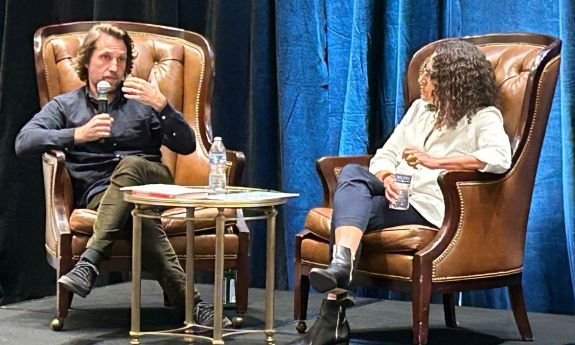A Searing Story of an Accident in East Jerusalem
Author Nathan Thrall discusses ‘A Day in the Life of Abed Salama’

Before discussing the accident, Thrall noted that for the past year, the war in Israel and Gaza has focused headlines nearly daily on the region. But at the time of the accident in 2012, there was “a large and growing kind of indifference to what was happening” in Palestinian communities. In particular, he said, the everyday experience of Palestinians living under military occupation in the West Bank has receded from public view.
“What I was aiming to do with this book was to draw our attention to the situation for Palestinians in their ordinary lives, the situation as it exists between these wars, between these moments when people are paying attention, because often when the wars would happen, you would hear global leaders and secretaries of state say, ‘we have to restore calm.’
“And what I really wanted to illustrate was that the calm that is the situation prior to the beginning of this particular war was anything but calm for Palestinians.”
Here are excerpts of Thrall’s comments at the event:
Why he selected this story
“I wanted to tell a specific story, to tell a narrative, to draw people into the lives of these Palestinians, and to really see, to have a visceral sense of what it is to live in this place. And it was a very deliberate choice on my part to tell the story of something as commonplace as a car accident, to show how radically different the sequence of events following a car accident are in this place, when you have this system of control over Palestinians.
“If you choose something exceptional, something that a journalist might be drawn to, it's easier to dismiss and say, this was the action of one bad commander. This is the action of one particular prime minister at this specific geopolitical moment. And what I really wanted to show is this is the system as it exists, no matter who's the prime minister, this is the system as it exists no matter who is the commander in the area.”
Salama’s search for his son
“When [Abed] arrived [at the accident], he saw a giant crowd, and all the children were gone. He asked where are the children? And people gave him various answers. They're at one hospital in East Jerusalem. They're at another hospital in West Jerusalem. They're at the military base, the Israeli military base, a minute up the road. They're at a hospital in Ramallah with some even as far as a hospital in Nablus.
“Now Abed has a green ID. That means he wasn't able to go through the checkpoints to see if his son was at the hospitals in East Jerusalem or at the hospitals in West Jerusalem. He certainly couldn't go to the military base a minute up the road, so he went to the one place that he could go, which was the hospital in Ramallah. And it took him more than a day just to find out where his son was. He called on relatives who had blue IDs, who were able to go through the checkpoints and look for his son at those hospitals.
“His journey that day through checkpoints and segregated roads allowed me to show that system, not from a kind of bird's eye view, but really from the perspective of one single person who is forced to navigate through it on the worst day of his life.”
Why he included Israeli characters in the book
“It was very important that all these characters in the book came across as real human beings, three-dimensional human beings, and that their world views were understandable to everybody, … different people whose lives kind of represent different slices of the experience of being in this place.
“One of the characters was the architect of the wall. … He created the maps that shaped the West Bank today, dividing it up into what is known as Area C, where all the Israeli Jewish settlements and military bases and settler roads and firing zones are located. This major contiguous area that's over 60% of the West Bank that's dotted with little areas of limited Palestinian autonomy known as area A and B. His name is Danny. He created the maps that really shaped the lives of all the people in the West Bank today, and he very much conceives of himself as a peacemaker, and I wanted to explain why he sees himself that way.”
The talk was sponsored by the Provost's Office, Department of Asian & Middle Eastern Studies, the Duke Human Rights Center at the Franklin Humanities Institute and the Duke Middle East Studies Center.
Nathan Thrall tells more about his book and his experience as a journalist in the Middle East in an interview with student Aseel Ibrahim of the Duke Human Rights Center at the Franklin Humanities Institute.